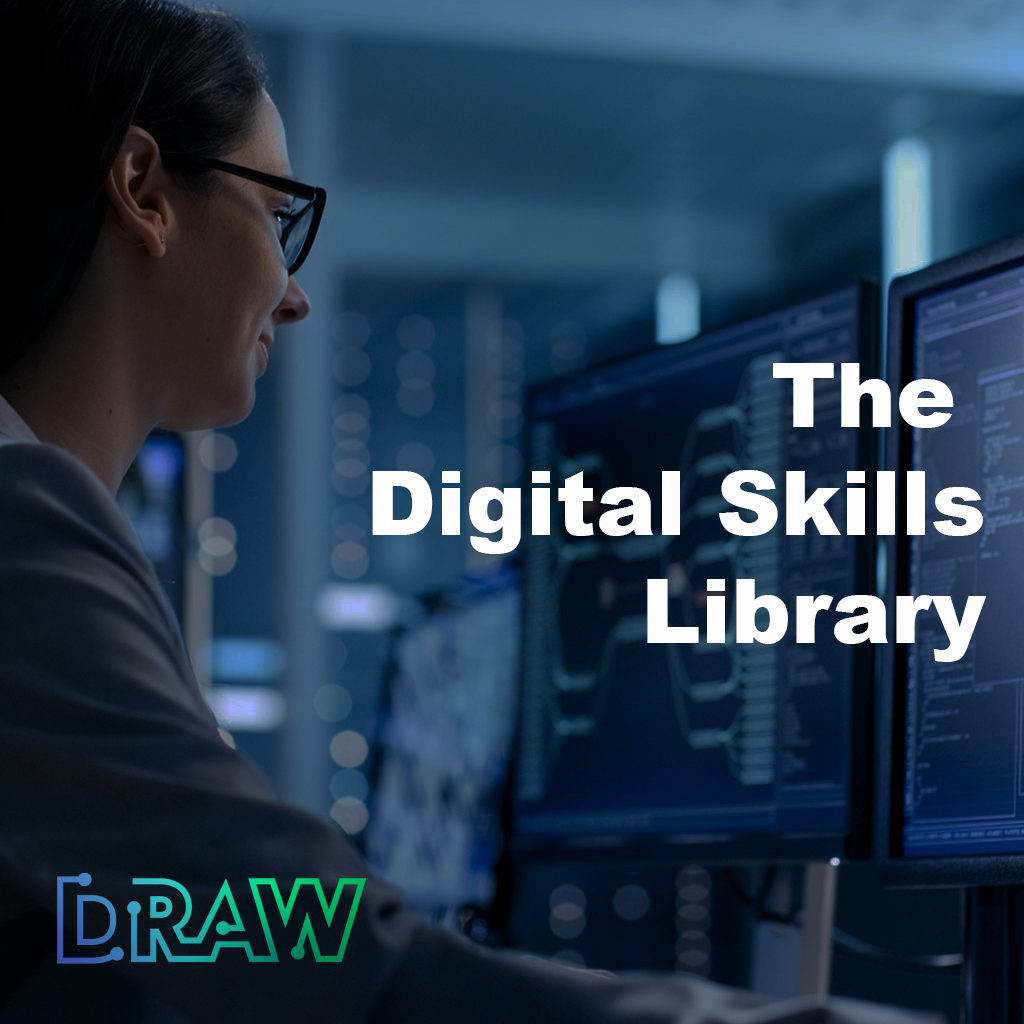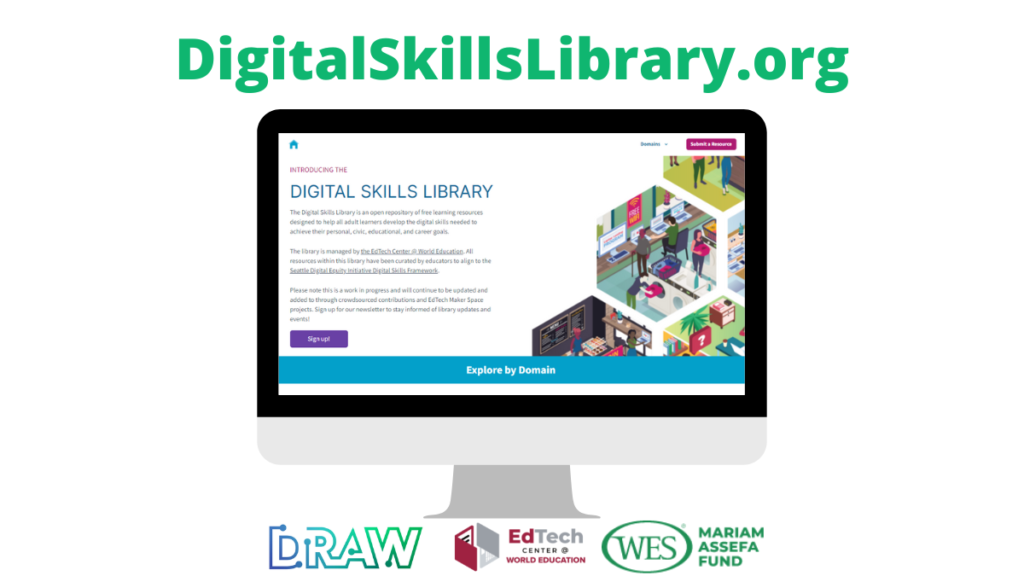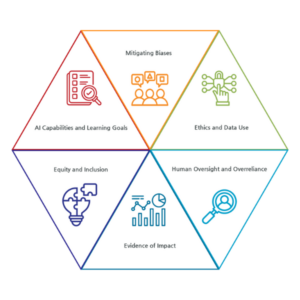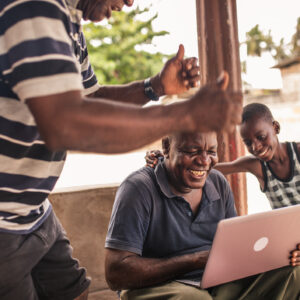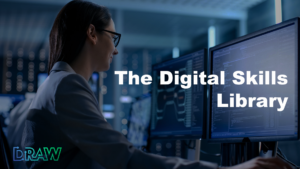
DRAW recently conducted a national landscape scan on digital literacy in which stakeholders identified trends and gaps in instructional content and curricula, along with frameworks focused on digital skills and competencies. To make the resources we discovered more useful to instructors, the DRAW team used a co-creation model called the EdTech Maker Space to find and curate instructional content. The EdTech Center @ World Education had previously engaged practitioners in curating digital skills instructional resources in alignment with the Seattle Digital Equity Initiative’s digital skills framework to create its free, openly available Digital Skills Library. From January to March 2022, DRAW used the EdTech Maker Space’s service-learning model to build on that earlier work by diving deeper into the library’s existing content and adding resources to fill in gaps.
The result: About 2,000 free activities for learning digital skills from roughly 20 different sources, organized into 10 domains, are now available at DigitalSkillsLibrary.org!
Introducing DigitalSkillsLibrary.org
DigitalSkillsLibrary.org was created by committed practitioners from community colleges, adult education and literacy organizations, and workforce development agencies across the United States and beyond who share the vision of a supporting a digitally resilient workforce. This resource addresses two of the major needs identified through the DRAW landscape scan: better awareness and access to instructional content, and better quality and variety for diverse learners.
Awareness and Access
As is the case in many sectors of education, the fundamental needs uncovered in the DRAW landscape scan were greater awareness around where content is located and, perhaps more pressing, how to easily access content for teaching specific skills. Instructional content needs to be streamlined so that staff members in a variety of roles and contexts can see what’s available and find what’s relevant.
The Digital Skills Library was built to enable stakeholders in any role, from learners to state leaders, to find what they need to learn or teach digital skills. The flexible search options provide multiple points of entry to locate materials. For example, teachers and administrators can search according to the Seattle Digital Equity Initiative’s digital skills framework to align their lesson objectives or a specific curriculum sequence. Those who are less familiar with the framework might prefer the open search feature, which allows users to search based on keywords and offers filtering options to narrow results according to their format, source, and language.
Many practitioners and experts emphasized in the landscape scan that it is important to provide openly licensed and affordable content that can be accessed and adapted for all. To address this, the license type is specified for each resource so users can quickly understand how they are allowed to use the content they find in the Digital Skills Library.
Quality and Variety for Diverse Learners
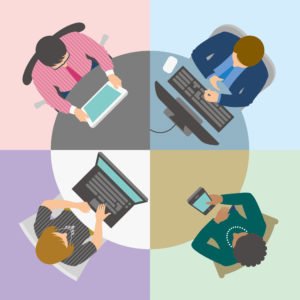
In addition to making the content available in a centralized, locatable format, the EdTech Maker Space project prioritized the addition of high-quality content that addresses high-priority skills and the needs of diverse learners. For this reason, the Digital Skills Library started with the best-known leaders in digital skills content, including GCFLearnFree, DigitalLearn.org, and Learn My Way. In winter 2022, the EdTech Maker Space content was honed further based on the 13 skills that the DRAW landscape scan identified as being a high priority for the workforce. Participants worked in skill groups and searched specifically for activities that support the acquisition of those 13 skills. Almost 200 additional resources were added in other languages, including Arabic, Hungarian, and Romanian, as well as the entirety of DigitalLearn.org’s Spanish content, to address the needs of linguistically diverse learners and educators.
DSL Resources and How to Get Involved
The work of the DRAW EdTech Maker Space is undeniably impactful in light of what was learned in the landscape scan. It is an impressive accomplishment resulting from a collaboration involving about 100 educators over the span of about one year.
The EdTech Maker Space is a unique professional development model that holds great promise for combining training with technology and creating open educational resources (OER). Depending on the project type, participants might be creating new OER, adapting existing OER to make it more user-friendly, or curating OER to make it more accessible. Anyone interested in learning more about the EdTech Maker Space model can access a free project design guide through CrowdED Learning, along with information about past and current projects. Past EdTech Maker Space participants have shared how the process has helped them create richer learning experiences for their students.
As technology continues to become more impressive, more functional, and more complex, workforce development agencies, employers, and adult educators must collaborate to keep up the momentum of promoting equity through digital resilience. For this reason, a “Submit a Resource” button sits prominently at the top of the Digital Skills Library. Resources can be submitted on the CrowdED Learning website as well.
To guide to those who want to get involved in this work, we have outlined a list of the types of content needed according to the landscape scan (numbered below); which resources already in the library address that need (🔍 In the Digital Skills Library); and which resources exist outside of the library that, when added, will make it a more robust tool for building digital skills and resilience (➕ What to add). The resources in the “What to add” section will be the focus of future curation efforts, but site visitors can use the Activity Submission Form to begin the curation process themselves and see the resources available in the library sooner.
1. Supports for Language Learning
English language learners are often acquiring digital skills and learning a new language concurrently. For this reason, activities that incorporate language-building activities and supports or explicit technology-related language instruction are needed in the library.
🔍In the Digital Skills Library, these sources provide vocabulary support:
-
- GCFLearnFree: Bold text and vocabulary lists in some lessons
- Common Sense Education: Vocabulary lists
- Google’s Applied Digital Skills: Key terms and concepts in the teacher lesson plan
- WISC-Online Basic Computer Skills: Glossaries
➕What to add:
2. Offline Access
Much of the content for teaching digital skills must be accessed online, exacerbating digital exclusion for those who don’t have reliable internet access and for adult learners in correctional settings. Content that is downloadable or printable will enable learners in those contexts to build digital skills.
🔍In the Digital Skills Library, these resources are available in PDF format:
-
- DigitalLearn.org’s courses
- Common Sense Education’s lesson guides and handouts
➕What to add:
-
- Learn My Way’s “Help Someone Else” resources, with PDF practice activities
3. Available in Multiple Languages
As the American workforce becomes increasingly multilingual, learners need to be able to access digital literacy resources in other languages to acquire terminology and skills that are relevant to their workplace, and to overcome language barriers that would otherwise put their digital skills development on hold. When teaching English language learners, “multilingual students benefit from being able to use their additional language repertoires to facilitate comprehension of content materials and instructions for completing tasks and assignments.”
🔍In the Digital Skills Library, these resources are available in other languages:
-
- DigitalLearn.org’s Spanish courses
- Some of GCFLearnFree’s Arabic lessons
- A collection of Hungarian and Romanian activities from various sources
➕What to add:
4. Integration With Other Content Areas
Adult educators teaching English, science, math, and other subjects might acknowledge the importance of digital literacy but struggle with the additional time required to integrate digital skills into their existing objectives and/or a lack of knowledge of digital literacy frameworks.
🔍In the Digital Skills Library, this need was addressed, in part, by selecting a flexible, user-friendly framework (by the Seattle Digital Equity Initiative) that will take some of the guesswork out of finding ways to integrate digital skills.
➕What to add: Aligning well-known core curricula to the library will further support efforts to integrate digital skills while increasing awareness around what these platforms offer in this area.
5. Functional in Various Instructional Models
As educational programs and employers settle into a new world of learning and working remotely, in person, and in blended formats, digital skills content needs to be able to accommodate synchronous and asynchronous as well as teacher-facilitated and self-paced learning experiences. These complex interactions can be supported through a range of instructional strategies, including direct instruction with the opportunity to apply inquiry-based learning, project-based learning, simulations, and more.
🔍In the Digital Skills Library, these resources work well for self-paced learning:
These support facilitated learning:
And these accommodate both:
➕What to add:
-
- More games, simulations, and projects that allow learners to practice skills
- More Google Applied Digital Skills projects
- Other resources for instruction, such as the I-DEA and Northstar Digital Literacy curricula
6. Mobile-Oriented
Focusing too narrowly on desktop and wired broadband may be increasingly out of step with the growth of “deskless” jobs in which workers use mobile devices, such as phones or tablets, to complete core job responsibilities. Therefore, activities for learning digital skills should be mobile-oriented, and the content within should reflect this transition from desktop to mobile.
🔍In the Digital Skills Library, Social Media TestDrive is an example of a resource that is both mobile-friendly and includes content relevant to mobile phone use. Other great content for learning to use mobile devices can be found under the Mobile domain on the library’s home page.
➕What to add: While many resources are mobile-friendly, resources that centralize mobile devices and are mobile-oriented are lacking. Cell-Ed is a leader in this area.
The EdTech Maker Space and resulting updates to the Digital Skills Library represent an important milestone in the DRAW initiative, as they fill a fundamental gap revealed in the landscape scan: the need to build awareness around and access to existing content for all stakeholders. The Digital Skills Library also sheds light on the high-quality content that exists for building digital resilience. Now, the collaborative effort continues as more content, with greater variety, is added to the library to better reflect the diversity of the American workforce.
As technology rapidly evolves, there’s a corresponding need for adults to develop digital literacy and digital resilience. In response, workforce experts, adult educators, and employers across the nation have been working together with adult learner-workers to address that burgeoning need. Among them is the Digital Resilience in the American Workforce (DRAW) project, an initiative from JFF, World Education, and Safal Partners that is funded by the U.S. Department of Education’s Office of Career, Technical, and Adult Education under contract GS10F0094X.

